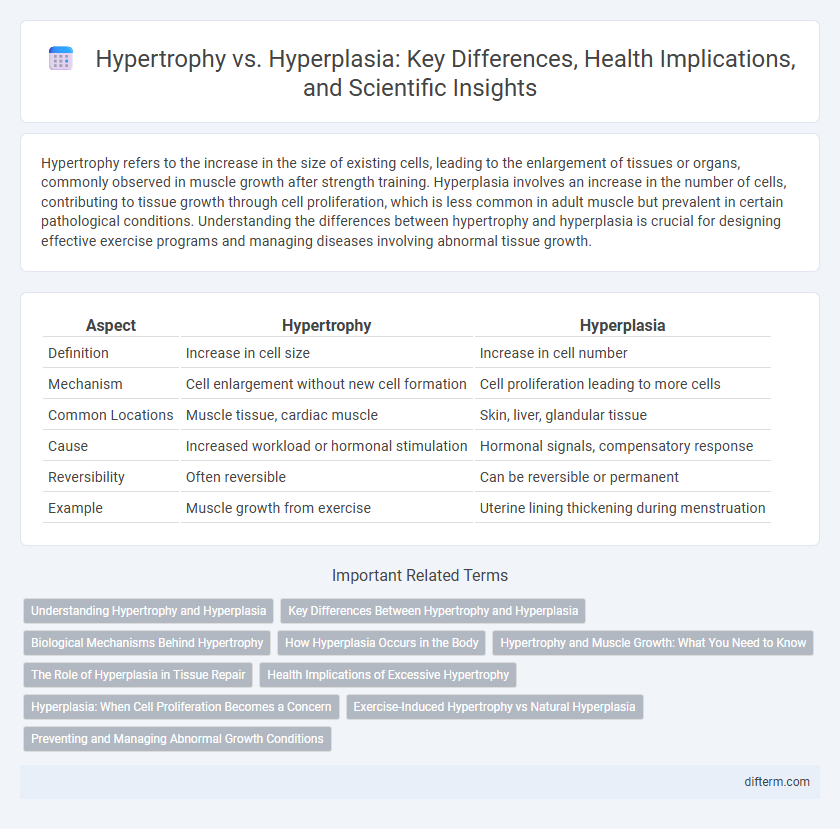Hypertrophy refers to the increase in the size of existing cells, leading to the enlargement of tissues or organs, commonly observed in muscle growth after strength training. Hyperplasia involves an increase in the number of cells, contributing to tissue growth through cell proliferation, which is less common in adult muscle but prevalent in certain pathological conditions. Understanding the differences between hypertrophy and hyperplasia is crucial for designing effective exercise programs and managing diseases involving abnormal tissue growth.
Table of Comparison
| Aspect | Hypertrophy | Hyperplasia |
|---|---|---|
| Definition | Increase in cell size | Increase in cell number |
| Mechanism | Cell enlargement without new cell formation | Cell proliferation leading to more cells |
| Common Locations | Muscle tissue, cardiac muscle | Skin, liver, glandular tissue |
| Cause | Increased workload or hormonal stimulation | Hormonal signals, compensatory response |
| Reversibility | Often reversible | Can be reversible or permanent |
| Example | Muscle growth from exercise | Uterine lining thickening during menstruation |
Understanding Hypertrophy and Hyperplasia
Hypertrophy refers to the increase in cell size, often seen in muscle tissue growth resulting from resistance training or load bearing. Hyperplasia involves an increase in the number of cells, commonly observed during tissue regeneration or in response to chronic stimuli in organs like the liver or skin. Both processes contribute to organ growth and adaptation but occur through distinct cellular mechanisms essential for health and disease management.
Key Differences Between Hypertrophy and Hyperplasia
Hypertrophy refers to the increase in cell size resulting in tissue enlargement, commonly seen in muscle growth due to resistance training, while hyperplasia involves an increase in cell number, often occurring during tissue regeneration or hormonal stimulation. Hypertrophy primarily enhances individual cell volume without cell division, whereas hyperplasia requires cellular proliferation to expand tissue mass. Understanding these processes is crucial for developing targeted therapies in conditions like muscle wasting, cancer, and organ hypertrophy.
Biological Mechanisms Behind Hypertrophy
Hypertrophy involves the enlargement of existing muscle cells through increased protein synthesis and satellite cell activation, resulting in greater muscle fiber size. This process is primarily driven by mechanical overload and metabolic stress, which trigger intracellular signaling pathways such as the mTOR pathway to enhance muscle growth. Unlike hyperplasia, hypertrophy does not increase the number of muscle fibers but improves muscle strength and mass by expanding the volume of individual fibers.
How Hyperplasia Occurs in the Body
Hyperplasia occurs in the body through an increase in the number of cells within a tissue or organ, often triggered by hormonal signals, chronic irritation, or physiological stress. This cellular proliferation is controlled by growth factors and specific gene activation pathways, leading to tissue enlargement without altering the size of individual cells. Key examples include the uterine lining growth during the menstrual cycle and liver regeneration after injury.
Hypertrophy and Muscle Growth: What You Need to Know
Muscle hypertrophy refers to the increase in muscle size due to the enlargement of existing muscle fibers, primarily driven by resistance training and adequate nutrition. This process involves the synthesis of new contractile proteins, leading to stronger and larger muscles, essential for athletic performance and injury prevention. Understanding hypertrophy helps optimize workout strategies for effective muscle growth and improved overall health.
The Role of Hyperplasia in Tissue Repair
Hyperplasia plays a crucial role in tissue repair by increasing the number of cells to replace damaged or lost tissue, enhancing the healing process. Unlike hypertrophy, which enlarges existing cells, hyperplasia restores tissue integrity through cellular proliferation driven by growth factors and cytokines. This regenerative mechanism is vital in organs with high regenerative capacity, such as the liver and skin, promoting recovery after injury.
Health Implications of Excessive Hypertrophy
Excessive hypertrophy, characterized by an abnormal increase in cell size, can lead to adverse health implications such as organ dysfunction and increased risk of cardiovascular diseases. Unlike hyperplasia, which involves cell proliferation, hypertrophy often results in metabolic strain and impaired tissue function due to enlarged cellular components. Monitoring hypertrophic changes is crucial for managing conditions like hypertensive heart disease and muscle disorders to prevent long-term health complications.
Hyperplasia: When Cell Proliferation Becomes a Concern
Hyperplasia involves an abnormal increase in cell numbers caused by accelerated cell proliferation, often triggered by chronic irritation or hormonal imbalances. This excessive cell multiplication can lead to tissue enlargement and may increase the risk of developing cancerous lesions if cellular growth becomes uncontrolled. Understanding the molecular signaling pathways, such as the role of growth factors like EGF and signaling proteins like mTOR, is crucial for developing targeted therapies to manage hyperplasia effectively.
Exercise-Induced Hypertrophy vs Natural Hyperplasia
Exercise-induced hypertrophy refers to the increase in muscle fiber size resulting from resistance training, characterized by enhanced protein synthesis and muscle fiber repair. Natural hyperplasia involves the formation of new muscle fibers, a process less commonly observed in humans and typically limited in response to anabolic stimuli rather than exercise alone. Understanding these mechanisms is crucial for optimizing training protocols aimed at muscle growth and functional strength gains.
Preventing and Managing Abnormal Growth Conditions
Hypertrophy and hyperplasia involve abnormal tissue growth, with hypertrophy characterized by an increase in cell size and hyperplasia by an increase in cell number. Preventing abnormal growth requires monitoring risk factors such as hormonal imbalances, chronic inflammation, and exposure to carcinogens. Managing these conditions often includes targeted therapies like anti-inflammatory medications, hormonal regulation, and lifestyle modifications to reduce cellular stress and inhibit pathological proliferation.
Hypertrophy vs Hyperplasia Infographic

 difterm.com
difterm.com